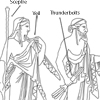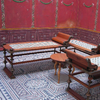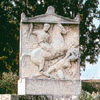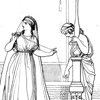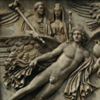Resources
Resources List
Reconstructing Antiquity is presented in three installations with distinct but interconnected themes. Works of art illustrating the many legends and myths of ancient Greece and Rome are featured in the John and Norah Warbeke Gallery. In the adjacent Gump Family Gallery, the focus on the storytelling is expanded into the sphere of theater and performance. Across the Museum in the Evans Gallery, objects offer a glimpse at the multi-faceted roles of women in ancient world. These themes and related issues are addressed in the brief articles below.
Warbeke Gallery wall text
The colorful adventures of gods and heroes were a source of inspiration not only for storytellers like Homer and Hesiod, but also for artists of the ancient world. From the eighth century BCE onward, mythological subjects...
Gump Gallery wall text
Public and private entertainments enjoyed by Greeks and Romans—musical recitals, theatrical performances and athletic games—were so pleasurable that a vast range of images was created to recall the experience...
Gump Gallery wall text
The fact that nearly every Greek and Roman town contained its own open-air theater attests to the widespread popularity of live entertainment, a tradition that probably originated from annual festivals...
Evans Gallery wall text
Greeks and Romans imagined a universe in which connections between the living and the dead remained strong. Through correct burial rites and prominent memorials, survivors showed due respect...
Evans Gallery wall text
In both Greek and Roman cultures, most women spent their days raising children, preparing food, and making clothing. Certainly exceptions did exist: women in poorer families would likely have left home...
Evans Gallery wall text
Ancient images of women are remarkable for their ambiguity. Sometimes, identification is straightforward: on the Gerasa mosaics at left, Erato, muse of lyric poetry, is easily recognized by her lyre and name...
Form and Function
Ceramic vessels provide the largest body of information for the study of ancient Greek culture and practices. Ranging in size, shape, and level of decoration, these containers served a variety of purposes not only in the daily lives of their owners, but also in honoring the dead.

